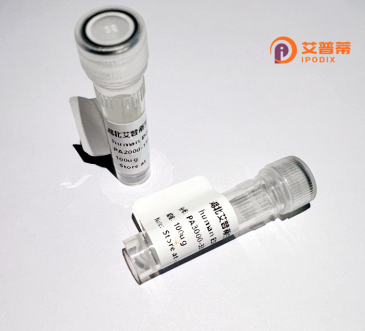
| 纯度 | >90%SDS-PAGE. |
| 种属 | Human |
| 靶点 | BTG3 |
| Uniprot No | Q14201 |
| 内毒素 | < 0.01EU/μg |
| 表达宿主 | E.coli |
| 表达区间 | 1-252aa |
| 氨基酸序列 | MKNEIAAVVF FFTRLVRKHD KLKKEAVERF AEKLTLILQE KYKNHWYPEK PSKGQAYRCI RVNKFQRVDP DVLKACENSC ILYSDLGLPK ELTLWVDPCE VCCRYGEKNN AFIVASFENK DENKDEISRK VTRALDKVTS DYHSGSSSSD EETSKEMEVK PSSVTAAASP VYQISELIFP PLPMWHPLPR KKPGMYRGNG HQNHYPPPVP FGYPNQGRKN KPYRPIPVTW VPPPGMHCDR NHWINPHMLA PH |
| 分子量 | 29.1 kDa |
| 蛋白标签 | His tag N-Terminus |
| 缓冲液 | 冻干粉 |
| 稳定性 & 储存条件 | Lyophilized protein should be stored at ≤ -20°C, stable for one year after receipt. Reconstituted protein solution can be stored at 2-8°C for 2-7 days. Aliquots of reconstituted samples are stable at ≤ -20°C for 3 months. |
| 复溶 | Always centrifuge tubes before opening.Do not mix by vortex or pipetting. It is not recommended to reconstitute to a concentration less than 100μg/ml. Dissolve the lyophilized protein in distilled water. Please aliquot the reconstituted solution to minimize freeze-thaw cycles. |
以下为关于重组人蛋白BTG3(BTG抗增殖蛋白家族成员3)的3篇代表性文献及其摘要概括:
1. **"BTG3 suppresses tumor progression by inducing apoptosis and modulation of TGF-β1 signaling in prostate cancer"**
- **作者**: Li Y. et al.
- **摘要**: 研究发现BTG3通过激活caspase依赖性凋亡通路抑制前列腺癌细胞增殖,并揭示其通过调控TGF-β1/Smad信号通路抑制肿瘤转移,提示BTG3可能作为前列腺癌的潜在治疗靶点。
2. **"BTG3 interacts with PRMT1 to regulate histone arginine methylation and neural differentiation"**
- **作者**: Park S.K. et al.
- **摘要**: 本文阐明了BTG3与蛋白质精氨酸甲基转移酶PRMT1的相互作用机制,证明BTG3通过调控组蛋白H4R3甲基化修饰影响神经干细胞分化,为BTG3在表观遗传调控中的作用提供依据。
3. **"Loss of BTG3 expression promotes melanoma metastasis through PAK4-mediated invasion and EMT"**
- **作者**: Zhang L. et al.
- **摘要**: 该研究通过临床样本和体外实验证明,BTG3低表达通过激活PAK4/Rho GTPase通路促进黑色素瘤细胞上皮间质转化(EMT)和侵袭转移,提示BTG3缺失可作为癌症预后的生物标志物。
如需更具体领域(如重组表达方法学)的文献,可进一步补充关键词进行筛选。
BTG3 (B-cell translocation gene 3) is a member of the BTG/Tob protein family, known for regulating cell cycle progression, differentiation, and apoptosis. This tumor suppressor gene, located on human chromosome 21q21.3. encodes a nucleoprotein implicated in DNA damage responses, transcriptional regulation, and chromatin remodeling. BTG3 interacts with p53 to mediate cell cycle arrest under genotoxic stress and inhibits cell proliferation by downregulating E2F1 activity. It also binds to the chromatin assembly factor CAF-1. influencing DNA replication-dependent chromatin dynamics. Structurally, BTG3 contains a conserved N-terminal BTG domain critical for protein interactions and a PAM2 motif involved in mRNA deadenylation. It is widely expressed in tissues, including the brain, kidney, and heart, but shows reduced expression in various cancers (e.g., prostate, lung, colorectal), correlating with poor prognosis. Studies link BTG3 to neurodevelopment and neurodegenerative diseases, such as Alzheimer's, where it may regulate synaptic plasticity. Recombinant human BTG3. produced via bacterial or eukaryotic expression systems, facilitates functional studies exploring its therapeutic potential as a diagnostic marker or therapeutic target in cancer and neurological disorders. Its multifaceted roles position BTG3 as a critical node in cellular homeostasis and disease pathways.
×